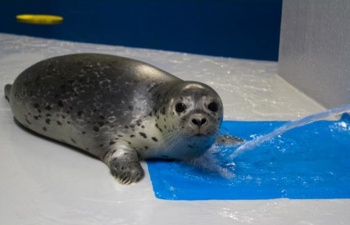
For wildlife biologists, understanding the basics about an animal species is key. How long does it live? How many babies does it have? When it comes to marine mammals, collecting this basic information can be a challenge.
But researchers at the Alaska SeaLife Center in Seward have developed a new way to track those elusive underwater creatures.
As the Science Director at the Alaska SeaLife Center, Markus Horning has spent years trying to understand harbor seals. He said there’s a lot we don’t know about them.
“We need data on survival, reproduction, the age at which female seals first breed and then how many offspring they have throughout their lives,” Horning said.
Because harbor seals spend so much time underwater and live in remote locations, he realized he would need to develop a special way to study them.
So he created a tag, but not just any kind of tag. It’s a lightweight pill-shaped device about the size of a C-battery. And it’s filled with sensors: temperature, motion and light.
Horning surgically implants these tags into seals. Despite its small size, the tag collects mountains of data. It has a little transmitter, so it can send all of the data back to a satellite. However, the tag can’t “talk” to the satellite when it’s inside the animal.
“To be able to reach a satellite at an elevation or 400 miles up in the sky, we need a very strong signal. Inside of the body, the signal is so weakened that we could never reach a satellite. So while the tag inside of the body, while the animal is alive, we can never hear from the tag. We don’t get any data,” Horning said.
The lightweight tag is filled with microscopic hollow glass balls to help it float. Once an animal dies, the tag eventually floats up to the water surface and transmits its information to a satellite.
“I would describe it as an electronic black box that is like a black box in an airplane,” Horing said. “It stores information about the state of the airplane and in this case the state of the seal, but it’s doesn’t really transmit that until after something bad happens. In this case, it doesn’t transmit until after an animal has died.”
All those years of information the tags collect can be a real gold mine for researchers like Horning. Not only can the tags tell how long an animal lived, they can also give us a good idea how it died.
“When we have a very abrupt temperature drop to ambient temperatures and when we have an immediate sensing of light and air, that’s when we assume the tag came out of the animal. Really the only way this could have happened is if the animal was dismembered by a predator,” Horning said.
This summer, Horning’s lab implanted tags in 10 harbor seals and released them near the Aleutian Islands. So far, they’re feeling hopeful. Based on pilot tests with Stellar sea lions, they have a 98 percent chance of receiving data once an animal dies.
They’re just not sure how long it’s going to take.
Shahla Farzan is a reporter with KBBI - Homer.
Shahla first caught the radio bug as a world music host for WMHC, the oldest college radio station operated exclusively by women. Before coming to KBBI, she worked at Capital Public Radio in Sacramento and as a science writer for the California Environmental Legacy Project. She is currently completing her Ph.D in ecology at the University of California-Davis, where she studies native bees.
When she's not producing audio stories, you can find Shahla beachcombing or buried in a good book.




